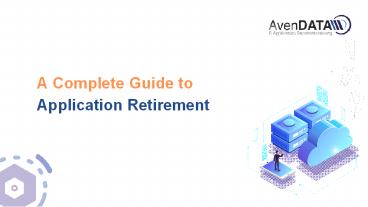Application Retirement Guide Definition, Benefits & Process - PowerPoint PPT Presentation
Title:
Application Retirement Guide Definition, Benefits & Process
Description:
Application retirement is the process of shutting down redundant or obsolete business applications. It is also Known as applications decommissioning. Although the application will still have access to old data, which is no longer needed by the organization. Source: – PowerPoint PPT presentation
Number of Views:5
Title: Application Retirement Guide Definition, Benefits & Process
1
A Complete Guide to Application Retirement
2
Definition Application retirement
Application retirement is the process of shutting
down redundant or obsolete business
applications. It is also Known as applications
decommissioning. Although the application will
still have access to old data, which is no
longer needed by the organization. It is
important to note that application retirement
does not affect a companys primary systems,
applications, or data instead, it does affect
secondary systems and applications such as No
Longer Required (NLR) software. While the
business may lose the ability to perform certain
tasks during this transition, this allows for
much- needed cost savings and resources.
3
Benefits of Applications Retirement
The benefits of IT application retirement are
many. One benefit is that it can helps to reduce
the overall cost of a companys IT budget.
Application decommission helps to eliminate the
maintenance, infrastructure, and licensing costs
associated with IT applications that are not
being used anymore and You can use that funds
for other purposes which are more important for
the business. Another advantage is that it can
help organizations to be more agile in their
business practices. It supports structured,
unstructured and semi-structured data and
content. It enables you to securely switch off
all legacy systems in compliance with legal
requirements so they wont have to worry about
any data leakages or security breaches.
4
Application Retirement Process
The application retirement process is an
important part of the life cycle of your
software. Here are the steps that you should
follow to complete a successful software
decommission.
5
Application Retirement Process
1) System analysis The initial step is the
system analysis. The purpose of the system
analysis is to enable us to estimate a time frame
for archiving your legacy system and calculate
costs, on the basis of which you can make your
decision and start planning. The result of the
system analysis is always a fixed price offer,
which you can accept or reject. In general, the
analysis takes less than two hours. The system
analysis process is divided into two parts
Technical part for clarification and Business
part for clarification. for more info System
analysis process specification about please click
below link. https//avendata.com/application-deco
mmissioning
6
Application Retirement Process
2) The archiving project After the system
analysis has been successfully done, you ask
yourself whether you want to start the project
with us. Once you have decided for the project,
there will be a kick off meeting in which your
team will get to know our experienced project
manager.
7
Application Retirement Process
3) User acceptance test - project handover The
last step is acceptance from your side. As you do
this, you will test samples, check the
certificate of completeness and documentation.
Furthermore, we would be happy to provide you
with all of our samples. And so you have an
extensive set of test data. If everything is
correct so far, you will receive an acceptance
report from us and you can shut down your system,
since all the necessary information can then be
reviewed within the ViewBox and properly
archived. From that moment on, the risks of the
legacy system are gone and you start saving money
Even after acceptance, we are certainly still
there for you through our support services.
8
Application Retirement Process































